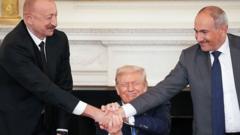In a dramatic shift in a long-standing dispute, the leaders of Azerbaijan and Armenia convened at the White House, where they signed a pivotal peace agreement aimed at concluding years of hostilities. President Donald Trump hosted the summit, where Azerbaijan's President Ilham Aliyev and Armenian Prime Minister Nikol Pashinyan formally shook hands, both leaders expressing optimism about the potential for lasting peace.
During the event, Trump lauded the agreement as “historic,” asserting that it would facilitate the reopening of critical transport routes between the two nations and bolster U.S. influence in the region. The longstanding conflict centered around Nagorno-Karabakh, an ethnically Armenian region within Azerbaijan, has persisted since the 1980s, with violence sporadically erupting over the decades.
“This agreement marks a new beginning,” Aliyev remarked, emphasizing years lost to war and bloodshed. Pashinyan echoed similar sentiments, characterizing the signing as a significant milestone in their relationship. For years, both countries have been in conflict, and the agreement is seen as a potential turning point towards amicable relations. Trump noted that both nations have pledged to cease all fighting indefinitely—a bold commitment towards peace.
The White House, in conjunction with the peace deal, announced plans for a major transit corridor, aptly named the Trump Route for International Peace and Prosperity, which is set to connect Azerbaijan and its Nakhchivan exclave, creating vital links previously hindered by territorial disputes. Given past tensions over transport access, this corridor symbolizes a hopeful shift in cooperation between the countries.
While praising Trump for facilitating the peace talks, Aliyev stated, “In six months, the President did a miracle.” Additionally, Trump revealed that a bilateral agreement with both nations would expand energy and technology trade, reinforcing the U.S.'s role as a significant player in the geopolitics of the region.
The recent developments mark the United States’ increasing influence, particularly as they come at a time when Russia, historically a central mediator in the conflict, has seen its role diminished. Russian President Vladimir Putin had been the architect behind the most recent agreements, but with the U.S. initiating this round of talks, the dynamics have notably shifted.
As the world watches how these newly established relations evolve, the commitments to peace signal a potential end to decades of suffering for both nations—a prospect many are cautiously optimistic about, even amidst lingering fears of renewed conflict.
During the event, Trump lauded the agreement as “historic,” asserting that it would facilitate the reopening of critical transport routes between the two nations and bolster U.S. influence in the region. The longstanding conflict centered around Nagorno-Karabakh, an ethnically Armenian region within Azerbaijan, has persisted since the 1980s, with violence sporadically erupting over the decades.
“This agreement marks a new beginning,” Aliyev remarked, emphasizing years lost to war and bloodshed. Pashinyan echoed similar sentiments, characterizing the signing as a significant milestone in their relationship. For years, both countries have been in conflict, and the agreement is seen as a potential turning point towards amicable relations. Trump noted that both nations have pledged to cease all fighting indefinitely—a bold commitment towards peace.
The White House, in conjunction with the peace deal, announced plans for a major transit corridor, aptly named the Trump Route for International Peace and Prosperity, which is set to connect Azerbaijan and its Nakhchivan exclave, creating vital links previously hindered by territorial disputes. Given past tensions over transport access, this corridor symbolizes a hopeful shift in cooperation between the countries.
While praising Trump for facilitating the peace talks, Aliyev stated, “In six months, the President did a miracle.” Additionally, Trump revealed that a bilateral agreement with both nations would expand energy and technology trade, reinforcing the U.S.'s role as a significant player in the geopolitics of the region.
The recent developments mark the United States’ increasing influence, particularly as they come at a time when Russia, historically a central mediator in the conflict, has seen its role diminished. Russian President Vladimir Putin had been the architect behind the most recent agreements, but with the U.S. initiating this round of talks, the dynamics have notably shifted.
As the world watches how these newly established relations evolve, the commitments to peace signal a potential end to decades of suffering for both nations—a prospect many are cautiously optimistic about, even amidst lingering fears of renewed conflict.


















